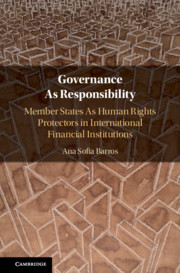 Governance As Responsibility
Governance As Responsibility Book contents
- Governance As Responsibility
- Governance As Responsibility
- Copyright page
- Dedication
- Contents
- Foreword
- Preface
- Acknowledgements
- Abbreviations
- Introduction
- I The Relationship between International (Financial) Institutions and Their Member States
- II Accounting for the Governance Role of Member States of International Financial Institutions in the Regime of International Responsibility
- III Member States As Human Rights Protectors in International Financial Institutions: Matching Governance with Responsibility
- Conclusion
- Bibliography
- Index
I - The Relationship between International (Financial) Institutions and Their Member States
Published online by Cambridge University Press: 28 June 2019
- Governance As Responsibility
- Governance As Responsibility
- Copyright page
- Dedication
- Contents
- Foreword
- Preface
- Acknowledgements
- Abbreviations
- Introduction
- I The Relationship between International (Financial) Institutions and Their Member States
- II Accounting for the Governance Role of Member States of International Financial Institutions in the Regime of International Responsibility
- III Member States As Human Rights Protectors in International Financial Institutions: Matching Governance with Responsibility
- Conclusion
- Bibliography
- Index
Summary
Chapter I discusses the relationship between international organisations and their member States and how both entities operate as international legal subjects. Looking underneath the veil of the legal personality of international organisations, it demonstrates that member States remain powerful actors in their own right, which has obvious implications for the application of international responsibility rules. With a focus on international financial institutions, the chapter begins by analysing the impact of State adhesion to international organisations, first from a domestic law perspective, and then from the viewpoint of international law, to highlight the notion that member States are continuously engaged in the exercise of the powers that they transferred to international organisations. Subsequently, and in order to clarify the borderline between both legal subjects, the chapter concentrates on the international legal personality of international organisations and how their legal distinctness comes about. It does so by exploring the concept of institutional autonomy. Against this backdrop, the chapter finalizes by shedding light into the elements that define member State conduct as subjects of international law. As the chapter concludes, such visibility is linked to the governance role of member States as ‘authority managers’ in international organisations.
Keywords
- Type
- Chapter
- Information
- Governance As ResponsibilityMember States As Human Rights Protectors in International Financial Institutions, pp. 21 - 59Publisher: Cambridge University PressPrint publication year: 2019


